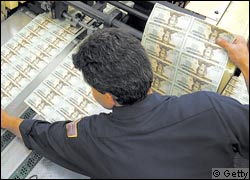 |
| $20 bills at the Bureau of Printing and Engraving in Washington: central banks are taking unprecedented action to increase the money supply by expanding their balance sheets |
A quiet revolution in central banking is gathering speed, as the Federal Reserve ploughs ever deeper into the brave new world of unorthodox monetary policy and other central banks ponder how far they might have to follow.
The world’s central banks have already undergone dramatic changes since the start of the credit crisis more than a year ago. They have cut interest rates with unprecedented rapidity – in some cases to historic lows – and have increased bank reserves massively to meet heightened private sector demand for liquidity.
They have become de facto central counterparties in the money markets, and in some cases even direct lenders to companies. Moreover, by making liquidity available against collateral on terms far more favourable than those that prevail in the private markets, they have become in effect catastrophic risk insurers of last resort for whole classes of financial assets – taking on the risk that the crisis could become so bad that they cannot recoup their loans.
But the latest steps by the Federal Reserve – which cut interest rates virtually to zero last week and said it would create money to finance ever-larger credit operations – break new ground.
Related:
– The Neo-Alchemy of the Federal Reserve by Ron Paul
– Interview: Peter Schiff still grim on future
Already the Fed arguably has one companion, the Bank of Japan. The BoJ cut rates to nearly zero on Friday, stepped up its purchases of government bonds and said it would buy commercial paper.
When central banks want to stimulate a slowing economy they normally cut interest rates. But when rates approach zero other tactics must be employed.
Like the Fed, the BoJ is likely to end up funding these purchases by expanding its holdings of bank reserves and therefore the narrowest measure of the money supply. Unlike the Fed, it has the option of issuing its own debt instead.
The Bank of England, while cautioning against assuming that it will follow the Fed into unorthodox territory, is thinking about what it might do in certain circumstances if UK interest rates also fell towards zero.
The European Central Bank as a whole is much less prepared to countenance the possibility that eurozone interest rates might end up so low. However, ECB officials say this does not rule out some forms of innovative operations.
That these issues are even being discussed in so many big economies is truly remarkable. Radical as the measures taken by central banks collectively to date are, the territory that lies beyond zero rates is still more unfamiliar.
Only Japan has any experience of unorthodox monetary policy. At the turn of this decade it adopted a strategy of quantitative easing – increasing the money supply by increasing bank reserves – in the hope that this would end deflation and boost lending.
The strategies under consideration today bear some resemblance to Japan’s quantitative easing, since they involve swelling the central bank’s balance sheet by more than the amount required to accommodate an increase in the private sector’s demand for liquidity.
Richard Berner, chief US economist at Morgan Stanley, says the Fed’s strategy amounts to “targeted QE”. But senior Fed officials do not think quantitative easing was a big success in Japan. The Fed says its own strategy is to stimulate the economy by driving down actual borrowing rates – increasing reserves only as a by-product- and it prefers to call this credit policy or credit-based easing.
Even the BoJ does not think quantitative easing was an enormous success, and denies that what it is doing now amounts to the same thing.
The ECB remains distinctly wary about further cuts in official borrowing costs, now at 2.5 per cent, with some officials concerned about running out of ammunition – a concern that runs directly contrary to Fed thinking – or of sowing the seeds of the next bubble.
However, the ECB could still follow the Fed into the realms of unconventional policy actions if necessary. Jean-Claude Trichet, president of the ECB, told the FT the ECB’s balance sheet had increased by an “impressive” 55 per cent compared with a year ago.
He did not rule out the possibility of the ECB buying government debt at some stage, even though such an option was not currently being considered.
The Bank of England, for its part, stresses that it is still in the realm of conventional policy, with rates at 2 per cent and no difficulty holding them there. It has nearly doubled the amount of reserves to £44.6bn over the past year, in line with its convention that banks can demand whatever reserve levels they choose once a month.
But the Bank is making contingency plans for what would happen if rates had to go close to zero. Charles Bean, the deputy governor, told the FT such policies might have to be considered before rates reach zero and banks have little incentive to manage liquidity. The “essential purpose”, he said, would be to drive borrowing rates lower, and stimulate spending – the same logic that drives the Fed approach.
Additional reporting by Chris Giles and Ralph Atkins
By Krishna Guha in Washington, Chris Giles in London and Ralph Atkins in Frankfurt
Published: December 22 2008 20:00 | Last updated: December 22 2008 20:00
Source: Financial Times
1 thought on “Central banks revolution gathers pace”